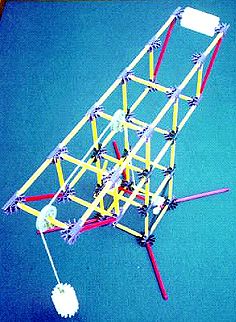
Crane challenge
Four large tractor wheels have fallen out of a helicopter flying over your school, and luckily landed in the playground when no-one was there. We need to put them on a lorry, as they are urgently needed by a local farmer. Can you help, by building a crane that will lift the wheels onto the back of the lorry?
Levels of difficulty:
Level 1 - Build a simple model of a crane
Level 2 - Build a crane with a hook on the end of the string that goes up and down when you turn a handle
Level 3 - As level 2, and the crane can pick up 4 of the larger K’NEX wheels and tyres without falling over
Equipment: K’NEX set, plus 1m length of string.
Approach: Do you know what cranes are used for? What do they look like? - there are lots of different types. How could you build one out of K’NEX? What shape will it be? For level 2, how can you add a handle, and a length of string that will make a hook go up and down when you turn the handle? For level 3, test your crane with 4 wheels on the hook. Does it work OK, or does it overbalance? If it does, how can you improve the design to prevent it overbalancing?
Handy Hints (please click to view):
A2 - 3 ways to connect K'NEX rods and connectors
A4 - Making corners with blue & purple connectors
W6 - Making rods turn with wheels or connectors
W7 - Pulleys
A11 - Making handles

Teachers' Notes
A practical project to design and build a model of a familiar working object. At level 3, a project which demonstrates the effects of balanced and unbalanced forces on a static object.
Possible solution: See photo.
Before starting: Look at pictures or real examples of different types of crane, and discuss how they work.
Conclusion: Test all the models in the class, to see whose model can lift the most wheels. Discuss the different ways in which the models achieve the objective, and why the design of the winning model is the best.
Copyright © Andy Shercliff 1996 and K'NEX User Group 2004





